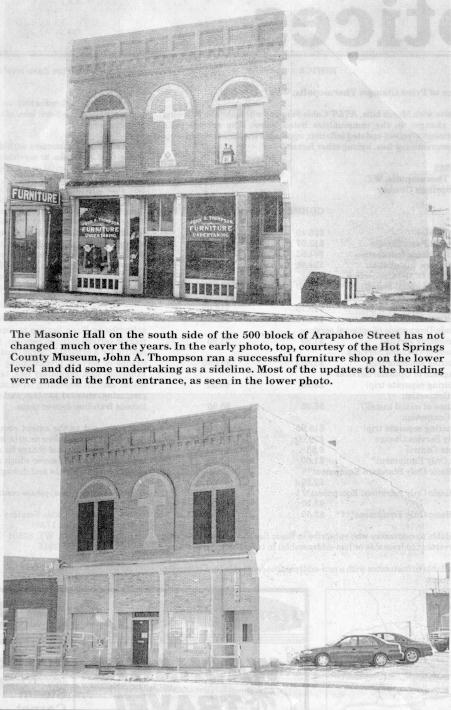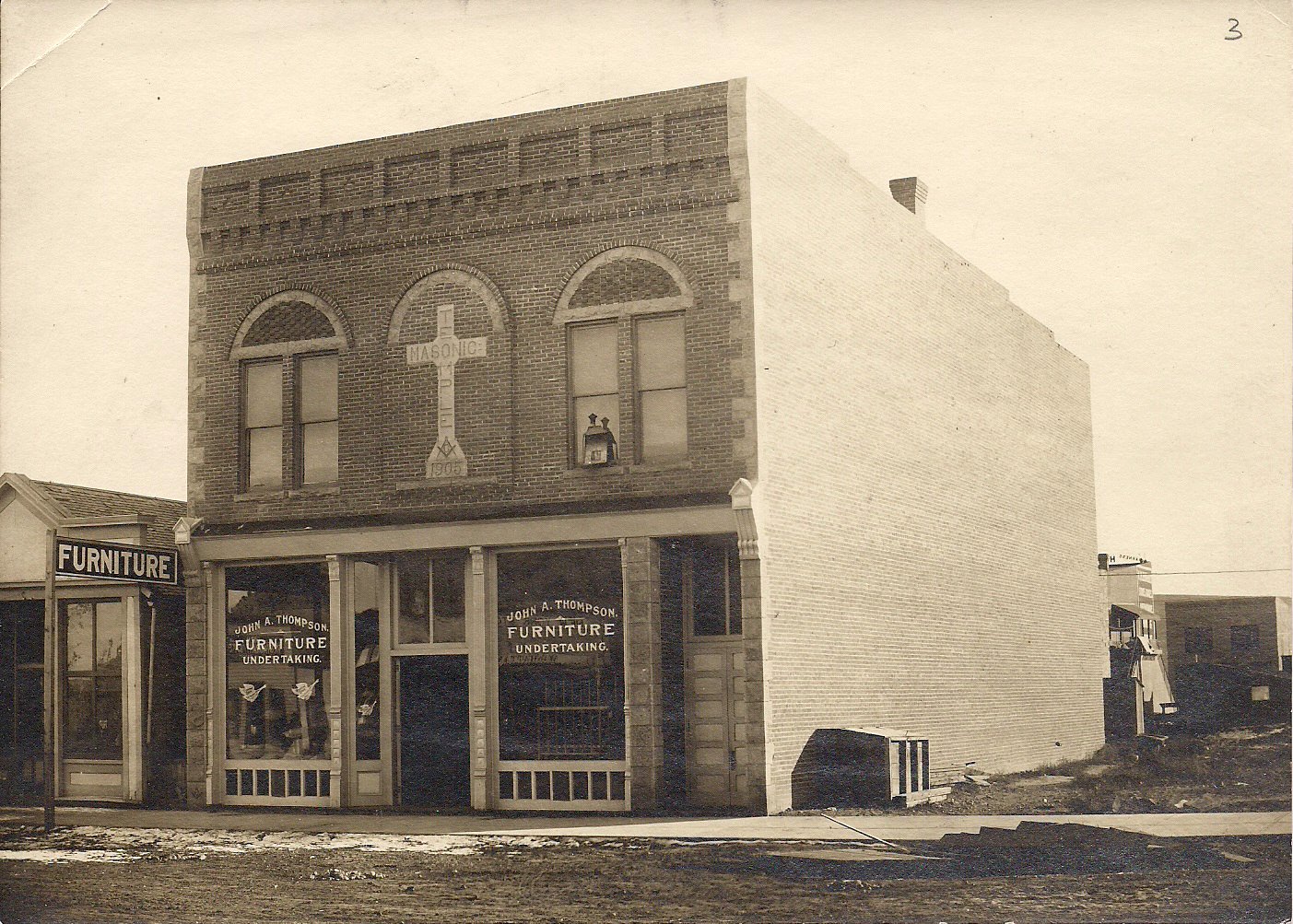


Malta Lodge #17, of Thermopolis, Wyoming, was issued Dispensation December 17, 1900, and was granted their charter September 4, 1901.

THERMOPOLIS, WYOMING, DECEMBER 29, 1921
TO THE WORSHIPFUL MASTER, OFFICERS AND BROTHERS OF THE MALTA LODGE NO. 17 A. F. & A.M.
You have requested me to write a history of the building of the Masonic Temple in Thermopolis and as one who was identified with the work of constructing the building, I will do the best I can to give to the lodge the experiences we passed through in that undertaking.
In the year 1899, a few Masons got together and having no Lodge closer than Lander, we decided to organize one in Thermopolis.
Not having a two story building in town at that time, we set about trying to get one. We saw Mr. J. L. MaCoy, who promised us that, if we would take a lease on the upper story of such a building for three years at $25.00 per month, he would build one. We agreed to this, but he afterwards discovered that he could also lease the room to the Odd Fellows and Woodmen, so he would not stand for such a lease but rented to us for $18.00 per month.
We met in that building until 1904, when it got so cold and leaked so badly that we could not stand it. So thirteen of us met and each of the thirteen donated $100.00 with which to purchase a lot upon which to build a Temple.
We elected a building committee which consisted of Brothers Hank. Fogg, and myself and we were given power to buy a lot, borrow money and build a hall.
We secured plans, specifications and estimates of the present hall and from the estimate we were assured that the same could be built for the sum of $8,000.00.
Mr. Fogg and Mr. Hank were at that time engaged in the live stock business on the mountain and had to give their attention to that business most of the time, so they appointed me, [at $3.00 per day] (written in later in pencil), as superintendent and instructed me to borrow the money and go ahead with the building.
We borrowed the $8,000.00 from Captain Torry for one year at ten percent interest. I bought the lot on which the building now stands from Mr. Bebb for $1,000. I let a contract to a local contractor at 33 and 1/3 cents per yard to dig the basement, hired two stone masons from Lander to lay the stone in the foundation and gave Mr. Chase a contract to furnish the stone at $1.00 per perch.
I gave a local contractor a contract to furnish lumber at $22.00 per thousand, and 5 per cent commission for the use of his name in purchasing lumber to be shipped from the coast. He also agreed to furnish the brick at $8.33 and 1/3 per thousand, delivered at the building. He afterwards refuse to deliver the brick because his profits did not come up to his expectations and he used his influence to hinder and delay the work when we got ready for the long timbers in the building. He told us that these timbers had been sawed at the mill but the teamsters would not load them, so I hired two teamsters and sent them to the mill, a distance of 60 miles, for the lumber. They came back with the report that there were no timbers there. I then went to him about it and he said they were liars; that the lumber was sawed.
I then hired a four horse team and another man and team and went to the mill myself, on the third day of July, 1905, got to the mill on the fourth; found that there was no long lumber sawed nor any logs on the ground to be sawed. I went through the timber adjacent to the mill and found there were no logs in reach of the mill that would make what we wanted.
We arrived home on the sixth day of July at noon. I then went to the agent of Mr. Robert A. Adams, who was running a mill at the head of Cottonwood, who said he thought they could furnish us the long timbers but that they would cost us at least $38.00 per thousand.
I then went to the barn, hired a team and buggy and started to the mill. I arrived there at 10:00 at night, told Mr. Adams what we wanted and he said he could furnish us the lumber but that he would have to have $42.00 per thousand for the same.
I closed a deal with him on those terms with the express understanding that he would send the lumber down right away. We went to the timber, picked the logs and he put his choppers at the work and before we left the mill, a part of the logs were in the yard.
We got home the night of the seventh at 11:00 and waited here for ten days for the lumber. I then again hired a team and started to hunt for it.
I found Mr. Adams had sawed the lumber according to the agreement and had started his son to town with it; but when he got over on Owl Creek, he met some boys and girls who were going out on Wind River fishing. So he turned his horses out and went with them, he had just returned when we got out there. As we could not get the brick delivered under our contract, I was compelled to hire teams to haul them, which I did.
We had our other lumber shipped to Cody, paid a $1.10 per hundred, wagon freight from Cody. Our glass came to Cody and the freighters refused to load it, so I had to pay $80.00 to get it recrated and then paid 3 cents per pound, wagon freight to Thermopolis, for hauling the same.
Receiving orders to get the building ready for the laying of the corner stone by July 24th, we rushed everything and on the 24th day of July, we laid the corner stone. Afterwards we proceeded with the laying of brick which was very slow work on account of there being so few brick layers in the country.
But with all of these hindrances, we proceeded with the building until in September, when we found our money was running short. We then made a loan of $3,500.00 through the First National Bank from Mr. Abbot of Cheyenne and the note was payable on demand at 12 per cent per annum. We completed the building on December 24th, 1905 at a total cost of $11,368.08.
In 1909, we found that the building did not pay the expenses and interest and under the circumstances it was necessary to raise the dues from $6.00 to $25.00 for that year. During the year 1906, Mr. Torry’s note became due and it had to be paid off. I made a trip to Cheyenne at my own expense to raise the money but failed. We then succeeded in getting a loan from a man in Iowa by giving our personal joint note. This note was signed by Brothers, Fogg, Hank, Thompson, Boots, Tom Walsh, Fouch, Pickard, Hayes, Joe Henry and myself. We gave the bank a mortgage for the $3500.00 which fell due in 1907. It became necessary for us to raise this money that year and, though times were hard, yet through the kindness of Brothers C. W. Ford, I succeeded in getting the loan. But it was necessary for us to give our personal notes for this money until 1908, when the building company was organized which took a mortgage from the Lodge and stood good for the money. We continued to pay ten per cent, until the winter of 1910, when Mr. A. K. Lee succeeded in bonding the hall for $8000.00 at six per cent and we then formed a stock company to take care of the rest of the indebtedness, with the exception of $1000.00 we owed the State Bank, which we paid the next year.
The stock holders in this company and who furnished the money to liquidate the indebtedness over and above the bonds were Brothers, C.E. Fogg, C.R. Hank, J.A. Thompson, J.A. Fouch, E.A. Boots, A.K. Lee, T.E. Walsh, David Pickard, Vincent Hayes, Joseph Henry, Brother Fenner, J.C. Danielson, J.W. Barr, and myself, each of whom contributed $550.00, except that Boots contributed $500.00, Beales $500.00, Fenner $100.00, Danielson $50.00 and Barr $50.00, all of which has since been paid off and we also have about $5000.00 on interest to apply on the bonds which falls due in the near future, so that the present indebtedness on the building is only about $3000.00.
I will say in conclusion, that many years have elapsed since my attention has been called to the details of these experiences. I regret that I can not prepare a better history then I am now able to submit but the best part of the history connected with the building of the Masonic Temple in Thermopolis is that every Mason connected with it manifested the true spirit of fraternalism. No Mason ever received a penny for the sacrifices and efforts made to secure this building and I feel the success of Masonry in this community has been due to the foundation prepared for it overcoming the difficulties we had to contend with in getting started.
Respectfully Submitted,
(signed) Ira Beals











 Lodge room pre 1959
Lodge room pre 1959